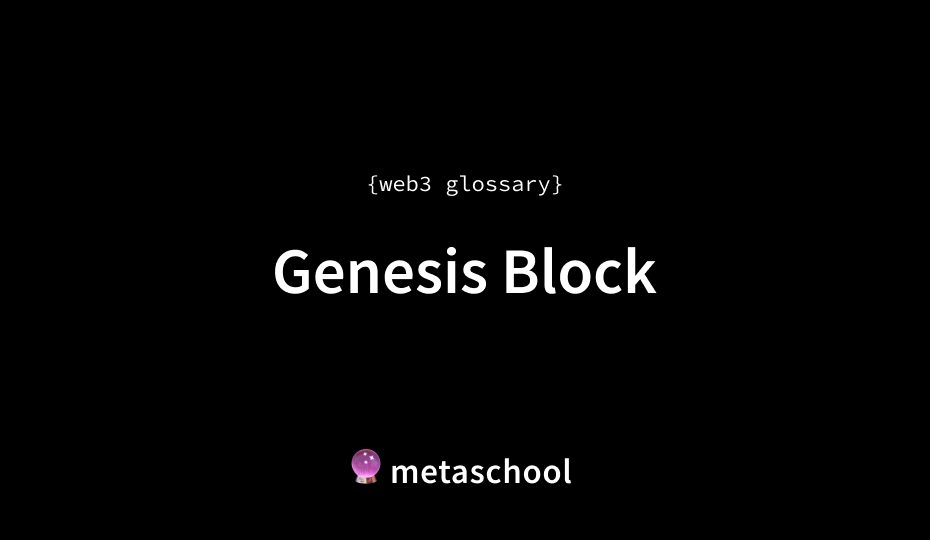Table of Contents
What is a Genesis Block?
Known also as Block 0, the Genesis Block is the very first block upon which additional blocks of a blockchain are added.
Each block in the blockchain is linked to and can trace its lineage back to the genesis block. This is particularly special, because all other blocks can be traced back to their preceding blocks and not any random block in the chain.
These blocks include timestamps, transaction records, and cryptographic hash of previous preceding blocks.
How it works
Suppose there are four blocks numbered 0, 1, 2, 3. The ‘0’ is the genesis block while 1, 2 and 3 are the blocks that come after, attached like a chain. So they would be connected in a way that Block 0 is connected to Block 1, Block 1 is connected to Block 2 and finally Block 2 is connected to Block 3.
🟥 🟦 🟦 🟦
Blocks 1, 2 and 3 contain the address of their previous blocks. For example Block 3 has the address of Block 2, Block 2 has the address of Block 1 and Block 1 has the address of the Genesis Block 0.
But the cool thing about being Block 0 is that Block 3 as well as Block 987 could trace its lineage back to the foundation i.e. the Genesis Block.
Origin of the Genesis Block
Now that you understand what the genesis block is, how it is characterized, and its features and importance, let’s dive into the genesis of the Genesis Block.
It was introduced with the creation of Bitcoin in 2009 because, after all, there is no Bitcoin without a genesis block.
The story of its creation, like its founder, is one that is mysterious and exciting.
Satoshi Nakamoto, the founder of Bitcoin, had prepared a whitepaper outlining his vision and what he thought of Bitcoin – a peer-to-peer electronic cash system with a ledger that maintains all big and small transactions.
The block was created with a total of 50 BTC and it had the headline for a Times article on January 3, 2009. The headline read, “Chancellor on brink of second bailout for banks”.
If the dots are connected, it seems as if Nakamoto knew that a virtual currency needed to step in to end long recessions in economies based on centralized markets and fiat currencies.
It is, thus, believed that Bitcoin was created on or after January 3 and as mind-boggling as it sounds, it was the start of the immutability of the currency.
To make changes in Bitcoin and to tamper with it without getting caught or triggering an effective recovery mechanism, a hacker would have to go back to the genesis block. It’s truly inspirational how the system has transpired and is basically dependent on a block that has a paltry 50 BTC.
The mysterious founder of Bitcoin, Satoshi Nakamoto, left 50 coins in the first block of Bitcoin which could not be used. Several thought it was a mistake, but it was pretty intentional.
Why was it done, though? There’s no definite answers but the internet does at occasion like to theorize.
We can’t talk about the Bitcoin Genesis Block without mentioning the now-famous “easter egg” Satoshi coded into the original 50 Bitcoin coin base.
The Times
🐣
Like Bitcoin or any other blockchain, the foundational block is also present on Ethereum. The Ethereum blockchain along with its Genesis Block was created in 2015.
It contained 8,893 transactions allocating various amounts of Ether to different addresses and a block reward of 5 ETH. Any transfer of that Ether on the Ethereum blockchain will have originated from one of these initial accounts (or from mining).
Conspiracies surrounding the Genesis Block
Conspiracy theorists have tons of explanations around the Genesis Block. This is primarily because unlike cryptocurrencies like Polkadot and Ethereum, Bitcoin’s founder is unknown. Apart from the name, not much is known about Nakamoto. It is also not clear whether it is an individual or a group of people.
Anyway, the first theory regarding the Genesis Block is that it contains some hidden messages that nobody can really access. Some believe that the reference to the Times article has something to do with the identity of the founder.
The second theory is that different forks – referring to a radical or big-scale change in blockchain – have taken place within the said blockchain. This has led to Bitcoin being split and the consequent creation of a new blockchain. The new blockchain may have a different Genesis Block.
Thus, people wonder whether Bitcoin is also the result of a fork and if the Genesis Block of Bitcoin is really the first-ever block.
Reservations
While controversies are there, there are also some reservations against the founder of Bitcoin. Some believe that because the founder had a first-mover advantage, they were able to mine the coins which is unfair to those who did not know about cryptocurrencies.
The second reservation is about the identity of the individual/group that created Bitcoin. Crypto claims to be transparent and the anonymity of the founder of one of the biggest blockchain networks goes against the very principle of crypto.
In conclusion, it would be impossible for us to know where the blockchain starts without the Genesis Block. We should consider the block as the foundation of a building; it would collapse without a solid foundation.
